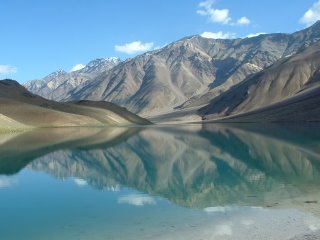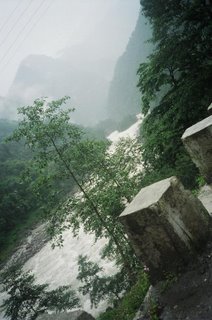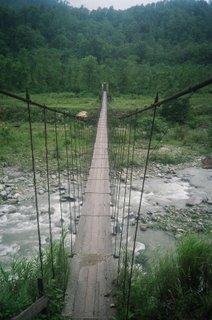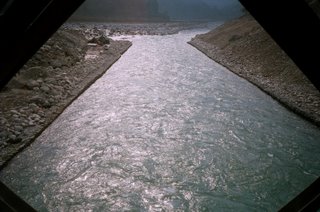Water Regime and Associated Dynamics in the Himalayas
Water has always been an essential resource for survival. The importance of a water-secure future is fully recognised in the millennium development goals and by all countries of the world. With nearly half of the globe, especially in North Africa, Middle East and South Asia, facing acute water crisis, water is increasingly becoming a security issue. In several areas, water demands are fast approaching the natural limits. As a result of the increasing pressure, future water security in many countries stand threatened.

Himalayan Water Ecosystem
The Himalayan system is the youngest ecosystem in the world that was formed during the tertiary geological period. Some of the tallest landforms of the world are found in this system. This ecosystem is one of the richest in the world in terms of biodiversity and bio-resources. It is regarded as the abode of god by the South Asians and hence revered intensely. Some of the great river systems of the world like Indus, Ganges and Brahmaputra are the integral part of the Himalayan Ecosystem. These apart, there are numerous smaller river systems that feature this loftiest landform of the world. It is of utmost interest to learn that majority of the rivers falling under the above river systems are antecedent in nature, meaning, the streams existed there before the mountain began to be uplifted. Most of the rivers have their sources in the trans-Himalayan locations well to the north of the Himalayan mountain system and flow parallel to the main range in the Tibetan highlands before entering Indian sub-continent through the Himalayas.
The Himalayan region stores one-fifth of the world’s fresh water. It is the fountainhead of water that sustains some 1.5 billion people. Hence the Himalayan River Ecosystem occupies a very significant position among the major biomes in South Asian Region and the World at large. However, we should realise that this system is also the youngest mountain system in the world and hence the most unstable. This system is still not free from the active tectonic disturbances and is the most complicated systems in the world in that a little deviation in its environmental components may lead to host of environmental hazards like landslide, soil seep, and other forms of mass wasting.

The importance of the Himalayan River System lies in the fact that major parts of the South Asian region (large part of Pakistan, India, Nepal, Bhutan, Bangladesh) rely on the water supplied from this system for drinking, agriculture, industry, power generation, transportation and other domestic activities. However, when they burst their banks Himalayan Rivers can make millions destitute. One fifth of Bangladesh is submerged every year, and during bad years like 1986 nearly 70 percent of the country goes underwater. Water makes life possible, but it also takes away lives. The rains bring the annual curse of landslides and erosion, which adds sediments to already, choked rivers. Roads, bridges, and railway tracks are washed away. Numerous glacial lakes located at the head of these rivers can bring destructive flashfloods when they burst. Global warming is gorging many Himalayan glacial lakes with snowmelt, which could push through their loose moraine dams at any time with cataclysmic floods downstream. Nevertheless, the same floods that destroy also bring valuable silt, replenishing nutrients in the soil.

Issues and Concerns
The recent development in this strategic northern frontier in terms of increasing human habitation, construction of roads, reckless tourism, overgrazing of livestock, unscientific agriculture expansion, depletion and degradation of forest resource to name only the important few have inflicted severe pressure on the carrying capacity of this fragile ecosystem. Recent studies, conducted by geographers, geologists and other scientists, clearly highlight that the temperature is rising, glaciers are melting and in some areas streams are drying up impacting the river regimes in the region posing a direct challenge to the planners and policy makers. If the decision makers do not take heed of the situation the time is not far to seek when the whole of the Himalaya will turn in to a cold desert.
The Himalayan river systems have sustained civilizations along its course that evolved over millennia. Today, the same rivers have come under the jurisdiction of different governments with conflicting interests. It is argued that ideally, transnational water resources planning must respect a river’s will and let it flow according to the parameters of a watershed and not national boundaries. The rivers make a mockery of artificial lines on the map. Worse, sharing the water of common rivers has now become an issue for conflict between and within nations. Our inability to prepare comprehensive river basin management plan has resulted in half the population of the Indus-Ganga-Brahmaputra belt living below the poverty line even as precious water is wasted.

Water is a subject that touches everyone, but it is little understood. Everyone has an opinion on water, and when water is concerned it seems emotion and passion sideline rational and scientific thinking. Further, what makes it murkier is that politics, populism and geopolitics get mixed up with the science. This is a pity, because Himalayan Rivers play a vital role in the people’s battle against hunger, providing water to hundreds of millions of farmers in Bangladesh, Bhutan, Nepal, India and Pakistan. But these countries have yet to develop ways to use this gift for the general good of their people. Mixing water with politics is a disservice to the people who is supposed to benefit from this precious fluid.
The other important fact which we need to take note at this point is that while water is getting scarcer in the Himalayas more valuable farmlands in the plains are turning flood-prone, or waterlogged. Embankments, which were initially designed to reduce floods made things worse. India has constructed more than 15,000 km of expensive levees after independence, with Bihar alone having more than 3,400 km. But floods are worse than ever before. Even so, governments in the region still spend millions on conventional and discredited methods of flood and erosion control.
Further, along with the embankments, proponents of the big dams, still view them as long-term solutions to meet power, irrigation and flood control requirements of the future. However, some ecologists and economists who see them as unsustainable due to high environmental, economic, and social costs are increasingly challenging big dams. In case of Hydel projects built thus far siltation has been a major problem, with projected capacities decreasing at alarming rates, often before the entire project is completed. Evaporation from the reservoirs and seepage of water from canals deprived the marginal land of the command area from the water that it was assured during the planning of the project. The dams that were designed to moderate floods have created floods by releasing excess water at the peak of the monsoon. In this connection it is important to note that more recently the government of India has been busy extending its gigantic development ventures, particularly the Hydel projects, in the Eastern Indian Himalayan region and the north eastern hills including Darjeeling-Sikkim Himalaya through its development agents mainly the NHPC (National Hydel Power Corporation). Some 168 high dams are being constructed in the fragile Construction of geomorphic unit of the Indian Himalayan System.

Such ventures of the government have raised several pertinent questions with respect to their objectives vis-à-vis the complex socio-cultural and ecological setup in the region. Three important attributes that need serious examination in this regard are-
First, the entire Himalaya is one of the youngest mountain systems in the world and hence tectonically and seismically still unstable. The massive construction works and the reservoirs created would increase the risk of seimicity.
Second, the Eastern Indian Himalaya including the Northeastern Hills is identified as one of the 25 global hotspots in terms of bio-diversity. Hence, the region is endowed with rich biodiversity and is a botanical wonderland. Any initiative like a massive Hydel dams in the region would therefore seriously impair the environmental health of the region.
Third, the region is inhabited, majorly, by the indigenous and tribal groups with unique social and cultural life styles different from the mainstream India. They regard their land and forest as the abode of god and therefore, any intrusion into their land and forest would invite serious socio-cultural tensions and may even lead to violent conflicts in this (already ethnically) vulnerable zone.
Hence, some of the pertinent questions that needs to be answered while building dams in this fragile resource zone are -
1.In the context of geo-environmental fragility
·Is the project economically viable in the region given the regions geographical and geo-environmental set up? What is the environmental cost of such projects?
·Will the tectonically/seismically sensitive area like Himalaya be able to support massive structures and the reservoirs they create?
·What will be the effects on the region’s intricate bio-relations and the biodiversity?
2.In the context of unique socio-cultural behaviour
·Development for whom! - Is it for the indigenous and tribal communities of the region or the mainstream fatties? /Or is it for some other people in the neighbouring countries?
·Is the government of India planning to venture into the power trading game at the cost of the eco-livelihood and the very existence of the indigenous and tribal community in the Himalaya?
·Are the people in the region happy with such capitalist ventures of the government / or Do the local people want such development at the first place?
·What is the degree and intensity of participation of the local people in the region who are directly and indirectly impacted by the project?
·How would, the displaced or rather ‘forcibly evicted’ people in such ventures be compensated- are the cash compensation enough to sustain and support their livelihood in the long run - what about the loss of traditional eco-cultural milieu of the indigenous and tribal in the region?
·What would be the fate of those living in the forest villages that do not have formal claim over their land – will they be compensated adequately?

Mention should be made that there has already been tremendous oppositions in the Eastern Himalayan Region with respect to these ambitious projects of the Government of India. Questions have been raised on many fronts by various voluntary organizations in and around the region, academia, and activists with respect to the socio-economic viability of the projects in the context of the geo-environmental fragility of the region.
Conclusion
There is a need to understand that there are symbiotic and intimate relationships between the natural resources. Destruction and degradation of one resource may directly or indirectly affect the existence of other valuable resources too. Water as resource among the resources is the life of mountain systems. Rivers as the base to all the resources help sustain other resources like natural vegetation, land and ultimately human being. Change in the river regime in uplands also negatively impact the resource base down stream, as there is again intimate relation between hills and plains. Managing the rivers and water sources holds promise for the future, but only if they are properly managed for the common good. Appropriate projects, carefully chosen and affordably built, cooperation between countries in the region alone can sustain the livelihood, healthy agriculture and robust industry to ensure better quality of life for one of the poorest and most-densely populated regions of the world, the Himalaya.
References
Bandyopadhyay, Mallik, Mandal and Perveen (2002), Dams and Development, Report on a policy dialogue, Indian Institute of Management, Calcutta.
Khawas, V. (2003), Various Postings on Indian Himalayas to North American Mountain Forum on the auspices of the e-discussion series “Mountains as Water Towers”, July 2003, www.mtnforum.org.
Madhukar, Upadhya (2001), Liquid assets -Two recent books on Himalayan water demystify and demythify this precious resource, A Review, Nepali Times, www.Nepalnews.com, July.
Rudra, K. (2003), Large Dams in North East India-Rivers, Forests, People and Power, Ecologist Asia, vol. 11, No. 1, January-February.
Water has always been an essential resource for survival. The importance of a water-secure future is fully recognised in the millennium development goals and by all countries of the world. With nearly half of the globe, especially in North Africa, Middle East and South Asia, facing acute water crisis, water is increasingly becoming a security issue. In several areas, water demands are fast approaching the natural limits. As a result of the increasing pressure, future water security in many countries stand threatened.

Himalayan Water Ecosystem
The Himalayan system is the youngest ecosystem in the world that was formed during the tertiary geological period. Some of the tallest landforms of the world are found in this system. This ecosystem is one of the richest in the world in terms of biodiversity and bio-resources. It is regarded as the abode of god by the South Asians and hence revered intensely. Some of the great river systems of the world like Indus, Ganges and Brahmaputra are the integral part of the Himalayan Ecosystem. These apart, there are numerous smaller river systems that feature this loftiest landform of the world. It is of utmost interest to learn that majority of the rivers falling under the above river systems are antecedent in nature, meaning, the streams existed there before the mountain began to be uplifted. Most of the rivers have their sources in the trans-Himalayan locations well to the north of the Himalayan mountain system and flow parallel to the main range in the Tibetan highlands before entering Indian sub-continent through the Himalayas.
The Himalayan region stores one-fifth of the world’s fresh water. It is the fountainhead of water that sustains some 1.5 billion people. Hence the Himalayan River Ecosystem occupies a very significant position among the major biomes in South Asian Region and the World at large. However, we should realise that this system is also the youngest mountain system in the world and hence the most unstable. This system is still not free from the active tectonic disturbances and is the most complicated systems in the world in that a little deviation in its environmental components may lead to host of environmental hazards like landslide, soil seep, and other forms of mass wasting.

The importance of the Himalayan River System lies in the fact that major parts of the South Asian region (large part of Pakistan, India, Nepal, Bhutan, Bangladesh) rely on the water supplied from this system for drinking, agriculture, industry, power generation, transportation and other domestic activities. However, when they burst their banks Himalayan Rivers can make millions destitute. One fifth of Bangladesh is submerged every year, and during bad years like 1986 nearly 70 percent of the country goes underwater. Water makes life possible, but it also takes away lives. The rains bring the annual curse of landslides and erosion, which adds sediments to already, choked rivers. Roads, bridges, and railway tracks are washed away. Numerous glacial lakes located at the head of these rivers can bring destructive flashfloods when they burst. Global warming is gorging many Himalayan glacial lakes with snowmelt, which could push through their loose moraine dams at any time with cataclysmic floods downstream. Nevertheless, the same floods that destroy also bring valuable silt, replenishing nutrients in the soil.

Issues and Concerns
The recent development in this strategic northern frontier in terms of increasing human habitation, construction of roads, reckless tourism, overgrazing of livestock, unscientific agriculture expansion, depletion and degradation of forest resource to name only the important few have inflicted severe pressure on the carrying capacity of this fragile ecosystem. Recent studies, conducted by geographers, geologists and other scientists, clearly highlight that the temperature is rising, glaciers are melting and in some areas streams are drying up impacting the river regimes in the region posing a direct challenge to the planners and policy makers. If the decision makers do not take heed of the situation the time is not far to seek when the whole of the Himalaya will turn in to a cold desert.
The Himalayan river systems have sustained civilizations along its course that evolved over millennia. Today, the same rivers have come under the jurisdiction of different governments with conflicting interests. It is argued that ideally, transnational water resources planning must respect a river’s will and let it flow according to the parameters of a watershed and not national boundaries. The rivers make a mockery of artificial lines on the map. Worse, sharing the water of common rivers has now become an issue for conflict between and within nations. Our inability to prepare comprehensive river basin management plan has resulted in half the population of the Indus-Ganga-Brahmaputra belt living below the poverty line even as precious water is wasted.

Water is a subject that touches everyone, but it is little understood. Everyone has an opinion on water, and when water is concerned it seems emotion and passion sideline rational and scientific thinking. Further, what makes it murkier is that politics, populism and geopolitics get mixed up with the science. This is a pity, because Himalayan Rivers play a vital role in the people’s battle against hunger, providing water to hundreds of millions of farmers in Bangladesh, Bhutan, Nepal, India and Pakistan. But these countries have yet to develop ways to use this gift for the general good of their people. Mixing water with politics is a disservice to the people who is supposed to benefit from this precious fluid.
The other important fact which we need to take note at this point is that while water is getting scarcer in the Himalayas more valuable farmlands in the plains are turning flood-prone, or waterlogged. Embankments, which were initially designed to reduce floods made things worse. India has constructed more than 15,000 km of expensive levees after independence, with Bihar alone having more than 3,400 km. But floods are worse than ever before. Even so, governments in the region still spend millions on conventional and discredited methods of flood and erosion control.
Further, along with the embankments, proponents of the big dams, still view them as long-term solutions to meet power, irrigation and flood control requirements of the future. However, some ecologists and economists who see them as unsustainable due to high environmental, economic, and social costs are increasingly challenging big dams. In case of Hydel projects built thus far siltation has been a major problem, with projected capacities decreasing at alarming rates, often before the entire project is completed. Evaporation from the reservoirs and seepage of water from canals deprived the marginal land of the command area from the water that it was assured during the planning of the project. The dams that were designed to moderate floods have created floods by releasing excess water at the peak of the monsoon. In this connection it is important to note that more recently the government of India has been busy extending its gigantic development ventures, particularly the Hydel projects, in the Eastern Indian Himalayan region and the north eastern hills including Darjeeling-Sikkim Himalaya through its development agents mainly the NHPC (National Hydel Power Corporation). Some 168 high dams are being constructed in the fragile Construction of geomorphic unit of the Indian Himalayan System.

Such ventures of the government have raised several pertinent questions with respect to their objectives vis-à-vis the complex socio-cultural and ecological setup in the region. Three important attributes that need serious examination in this regard are-
First, the entire Himalaya is one of the youngest mountain systems in the world and hence tectonically and seismically still unstable. The massive construction works and the reservoirs created would increase the risk of seimicity.
Second, the Eastern Indian Himalaya including the Northeastern Hills is identified as one of the 25 global hotspots in terms of bio-diversity. Hence, the region is endowed with rich biodiversity and is a botanical wonderland. Any initiative like a massive Hydel dams in the region would therefore seriously impair the environmental health of the region.
Third, the region is inhabited, majorly, by the indigenous and tribal groups with unique social and cultural life styles different from the mainstream India. They regard their land and forest as the abode of god and therefore, any intrusion into their land and forest would invite serious socio-cultural tensions and may even lead to violent conflicts in this (already ethnically) vulnerable zone.
Hence, some of the pertinent questions that needs to be answered while building dams in this fragile resource zone are -
1.In the context of geo-environmental fragility
·Is the project economically viable in the region given the regions geographical and geo-environmental set up? What is the environmental cost of such projects?
·Will the tectonically/seismically sensitive area like Himalaya be able to support massive structures and the reservoirs they create?
·What will be the effects on the region’s intricate bio-relations and the biodiversity?
2.In the context of unique socio-cultural behaviour
·Development for whom! - Is it for the indigenous and tribal communities of the region or the mainstream fatties? /Or is it for some other people in the neighbouring countries?
·Is the government of India planning to venture into the power trading game at the cost of the eco-livelihood and the very existence of the indigenous and tribal community in the Himalaya?
·Are the people in the region happy with such capitalist ventures of the government / or Do the local people want such development at the first place?
·What is the degree and intensity of participation of the local people in the region who are directly and indirectly impacted by the project?
·How would, the displaced or rather ‘forcibly evicted’ people in such ventures be compensated- are the cash compensation enough to sustain and support their livelihood in the long run - what about the loss of traditional eco-cultural milieu of the indigenous and tribal in the region?
·What would be the fate of those living in the forest villages that do not have formal claim over their land – will they be compensated adequately?

Mention should be made that there has already been tremendous oppositions in the Eastern Himalayan Region with respect to these ambitious projects of the Government of India. Questions have been raised on many fronts by various voluntary organizations in and around the region, academia, and activists with respect to the socio-economic viability of the projects in the context of the geo-environmental fragility of the region.
Conclusion
There is a need to understand that there are symbiotic and intimate relationships between the natural resources. Destruction and degradation of one resource may directly or indirectly affect the existence of other valuable resources too. Water as resource among the resources is the life of mountain systems. Rivers as the base to all the resources help sustain other resources like natural vegetation, land and ultimately human being. Change in the river regime in uplands also negatively impact the resource base down stream, as there is again intimate relation between hills and plains. Managing the rivers and water sources holds promise for the future, but only if they are properly managed for the common good. Appropriate projects, carefully chosen and affordably built, cooperation between countries in the region alone can sustain the livelihood, healthy agriculture and robust industry to ensure better quality of life for one of the poorest and most-densely populated regions of the world, the Himalaya.
References
Bandyopadhyay, Mallik, Mandal and Perveen (2002), Dams and Development, Report on a policy dialogue, Indian Institute of Management, Calcutta.
Khawas, V. (2003), Various Postings on Indian Himalayas to North American Mountain Forum on the auspices of the e-discussion series “Mountains as Water Towers”, July 2003, www.mtnforum.org.
Madhukar, Upadhya (2001), Liquid assets -Two recent books on Himalayan water demystify and demythify this precious resource, A Review, Nepali Times, www.Nepalnews.com, July.
Rudra, K. (2003), Large Dams in North East India-Rivers, Forests, People and Power, Ecologist Asia, vol. 11, No. 1, January-February.

0 Comments:
Post a Comment
<< Home